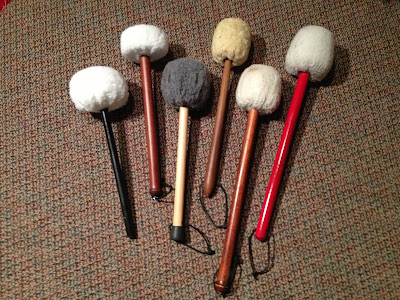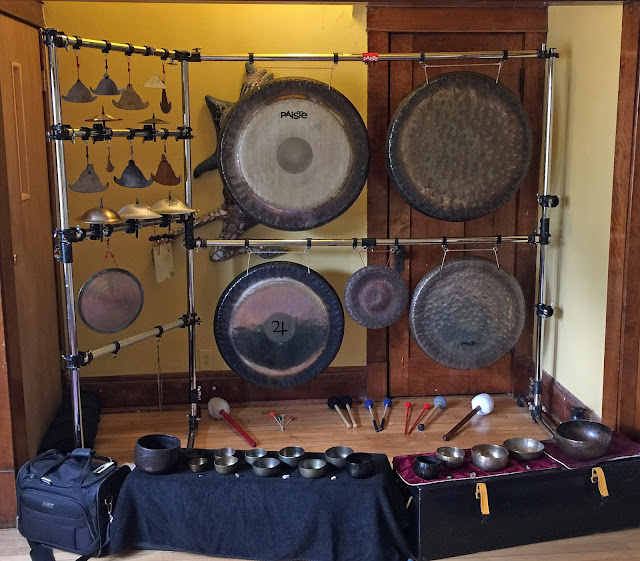Mail Call: Playing Small places & Mallet Advice
I get a lot of e-mail with questions from drummers & Gongers about a wide range of things. Today I'd like to address a question I received yesterday:
I am seeking some advice with mallets. A few of the yoga studios I play at are smallish, they fit about 20 people mat to mat and have short ceilings. The gongs end up becoming intense in such small spaces, almost too intense.
Do you have any advice as to what kind of mallet might be a soft, gentle, roller that could work better than the paiste mallets in such small spaces? I have a few different kinds (paiste, chinese, and some z brand mallets) but they still get pretty big and tingy. any suggestions on how to handle these spaces either with mallets or otherwise?
First thing: it's rarely about the mallets. It's all about the technique.
I regularly play places that hold from 20 people, to places that can hold 100. In all situations I use the same instruments and the same mallets. When I change the mallets, it's all about changing the sound, not the volume.
If you are playing a large Gong, like a 24" and up, to get a full, deep sound, you need a heavy, big headed mallet. A smaller mallet won't be able to bring out the deeper tones. Similarly, if you use a super soft mallet, it will be difficult to get the mass of the metal to move and produce a rich, full sound.
For rollers, I use either the Mike Balter GM4s, or the Orpheus Percussion ZIs. Both are fairly heavy, with a medium sized head. The ZIs are a bit more padded, but still firm. The thing I like about the GM4s, is that they have a lot of weight in the mallet head, so I don't have to work as hard to get the sound to come out.
Sometimes I'll use the Balter Wind Gong Mallets as rollers, but they don't bring out the bottom end on a large Gong—so it depends on the sound I'm looking for.
It's that simple. Think of a trumpet player, or a violinist, they don't change mouthpieces, or bows, to play quieter. They just play quieter.
It's easy to play a Gong loudly, but it takes a lot of work to learn how to play it softly and still bring out a full sound. I've spent hours and hours just practicing playing quietly, and developing some specific techniques to enable me to create a strong, yet quiet sound field in smaller places.
As I've written in previous posts, you've got to do the work. Don't just expect to take the Gong out on Saturday for that Yoga session and then pack it away until the next session.
You need to practice.
You need to devote yourself to learning how to control the sound.
You need to realize that the Gong takes a lifetime to master.
You need to do the work.
Various large, padded mallets
If you are playing a large Gong, like a 24" and up, to get a full, deep sound, you need a heavy, big headed mallet. A smaller mallet won't be able to bring out the deeper tones. Similarly, if you use a super soft mallet, it will be difficult to get the mass of the metal to move and produce a rich, full sound.
For rollers, I use either the Mike Balter GM4s, or the Orpheus Percussion ZIs. Both are fairly heavy, with a medium sized head. The ZIs are a bit more padded, but still firm. The thing I like about the GM4s, is that they have a lot of weight in the mallet head, so I don't have to work as hard to get the sound to come out.
Balter Wind, GM4, GM3, GM1
Sometimes I'll use the Balter Wind Gong Mallets as rollers, but they don't bring out the bottom end on a large Gong—so it depends on the sound I'm looking for.
What this all comes down to is practice and learning to play softly.
It's that simple. Think of a trumpet player, or a violinist, they don't change mouthpieces, or bows, to play quieter. They just play quieter.
It's easy to play a Gong loudly, but it takes a lot of work to learn how to play it softly and still bring out a full sound. I've spent hours and hours just practicing playing quietly, and developing some specific techniques to enable me to create a strong, yet quiet sound field in smaller places.
As I've written in previous posts, you've got to do the work. Don't just expect to take the Gong out on Saturday for that Yoga session and then pack it away until the next session.
You need to practice.
You need to devote yourself to learning how to control the sound.
You need to realize that the Gong takes a lifetime to master.
You need to do the work.
~ MB
Chop Wood | Carry Water | Play Gongs





Comments
Post a Comment